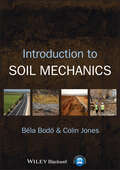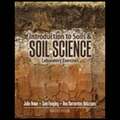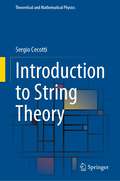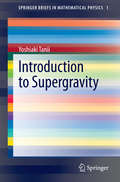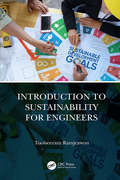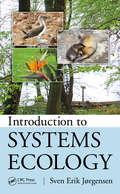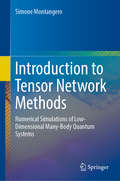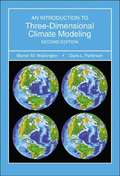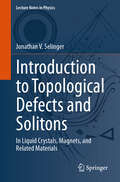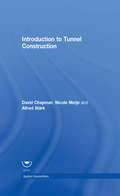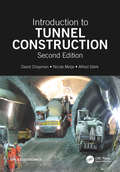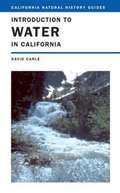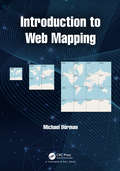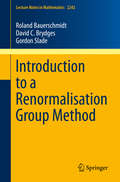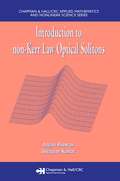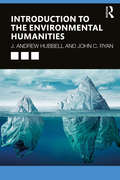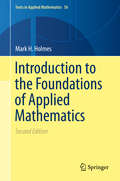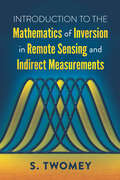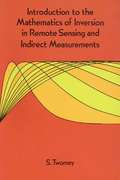- Table View
- List View
Introduction to Soil Mechanics
by Colin Jones Béla BodóIntroduction to Soil Mechanics, Béla Bodó & Colin Jones Introduction to Soil Mechanics covers the basic principles of soil mechanics, illustrating why the properties of soil are important, the techniques used to understand and characterise soil behaviour and how that knowledge is then applied in construction. The authors have endeavoured to define and discuss the principles and concepts concisely, providing clear, detailed explanations, and a well-illustrated text with diagrams, charts, graphs and tables. With many practical, worked examples and end-of-chapter and coverage of Eurocode 7, Introduction to Soil Mechanics will be an ideal starting point for the study of soil mechanics and geotechnical engineering. About the Authors Béla Bodó B.Sc., B.A., C.Eng., M.I.C.E, was born in Hungary and studied at Budapest Technical University, the University of London and the Open University. He developed his expertise in Soil Mechanics during his employment with British Rail and British Coal. Colin Jones B.Sc, C. Eng., M.I.C.E, P.G.C.E, studied at the University of Dundee, and worked at British Coal where he and Béla were colleagues. He has recently retired from the University of Wales, Newport where he was Programme Director for the Civil Engineering provision, specializing in Soil Mechanics and Geotechnics. Also Available Fundamentals of Rock Mechanics 4th Edition J C Jaeger, N G W Cook and R Zimmerman Hardcover: 9780632057597 Smith's Elements of Soil Mechanics 8th Edition Ian Smith Paperback: 9781405133708
Introduction to Soils and Soil Science: Laboratory Exercises
by Sam Feagley Julie Howe Ana Barrientos VelazquezIntroduction to Soils & Soil Science is designed for use in a course that will give the student a comprehensive introduction to the nature and properties of soils. The thrust of the manual is to provide general information about each topic to be studied. As the work is completed, the student makes observations about basic concepts that are important in all soils, while finding out more about the particular sample that the student obtains for study.
Introduction to Soils and Soil Science: Laboratory Exercises
by Murray H. MilfordLab Manual that explores soil science
Introduction to String Theory (Theoretical and Mathematical Physics)
by Sergio CecottiGraduate students typically enter into courses on string theory having little to no familiarity with the mathematical background so crucial to the discipline. As such, this book, based on lecture notes, edited and expanded, from the graduate course taught by the author at SISSA and BIMSA, places particular emphasis on said mathematical background. The target audience for the book includes students of both theoretical physics and mathematics. This explains the book’s "strange" style: on the one hand, it is highly didactic and explicit, with a host of examples for the physicists, but, in addition, there are also almost 100 separate technical boxes, appendices, and starred sections, in which matters discussed in the main text are put into a broader mathematical perspective, while deeper and more rigorous points of view (particularly those from the modern era) are presented. The boxes also serve to further shore up the reader’s understanding of the underlying math. In writing this book, the author’s goal was not to achieve any sort of definitive conciseness, opting instead for clarity and "completeness". To this end, several arguments are presented more than once from different viewpoints and in varying contexts.
Introduction to Strong Interactions: Theory and Applications
by Andrey GrabovskyThis is a problem-oriented introduction to the main ideas, methods, and problems needed to form a basic understanding of the theory of strong interactions. Each section contains solid but concise technical foundations to key concepts of the theory, and the level of rigor is appropriate for readers with a background in physics (rather than mathematics). It begins with a foundational introduction to topics including SU(N) group, hadrons and effective SU(3) symmetric flavor lagrangians, constituent quarks in hadrons, quarks and gluons as fundamental fields. It then discusses Quantum chromodynamics as a gauge field theory, functional integration, and Wilson lines and loops, before moving on to discuss gauge–fixing and Faddeev – Popov ghosts, Becchi-Rouet-Stora-Tyutin symmetry, and lattice methods. It concludes with a discussion on the anomalies and the strong CP problem, effective action, chiral perturbation theory, deep inelastic scattering, and derivation and solution of the Dokshitzer - Gribov - Lipatov - Altarelli - Parisi equations. Constructed as a one-term course on strong interactions for advanced students, it will be a useful self-study guide for graduate and PhD students of high energy physics, Quantum Chromodynamics, and the Standard Model.
Introduction to Supergravity
by Yoshiaki TaniiThis book is a pedagogical introduction to supergravity, a gravitational field theory that includes supersymmetry (symmetry between bosons and fermions) and is a generalization of Einstein's general relativity. Supergravity provides a low-energy effective theory of superstring theory, which has attracted much attention as a candidate for the unified theory of fundamental particles, and it is a useful tool for studying non-perturbative properties of superstring theory such as D-branes and string duality. This work considers classical supergravities in four and higher spacetime dimensions with their applications to superstring theory in mind. More concretely, it discusses classical Lagrangians (or field equations) and symmetry properties of supergravities. Besides local symmetries, supergravities often have global non-compact symmetries, which play a crucial role in their applications to superstring theory. One of the main features of this book is its detailed discussion of these non-compact symmetries. The aim of the book is twofold. One is to explain the basic ideas of supergravity to those who are not familiar with it. Toward that end, the discussions are made both pedagogical and concrete by stating equations explicitly. The other is to collect relevant formulae in one place so as to be useful for applications to string theory. The subjects discussed in this book include the vielbein formulation of gravity, supergravities in four dimensions, possible types of spinors in various dimensions, superalgebras and supermultiplets, non-linear sigma models for non-compact Lie groups, electric-magnetic duality symmetries, supergravities in higher dimensions, dimensional reductions, and gauged and massive supergravities.
Introduction to Sustainability for Engineers
by Toolseeram RamjeawonIntroduction to Sustainability for Engineers aims to incorporate sustainability into curricula for undergraduate engineering students. The book starts with an introduction to the concept of sustainability, outlining core principles for sustainable development to guide engineering practice and decision making, including key tools aimed at enabling, measuring and communicating sustainability. It also describes concepts as life cycle assessment, environmental economics, related institutional architecture and policy framework, business context of sustainability, and sustainable buildings and infrastructure. Appendices at the end of the book presents a summary of key concepts, strategies and tools introduced in the main text. Five Key Benefits: A comprehensive textbook for engineering students to develop competency in sustainability. Presents a framework for engineers to put sustainability into practice. Presents the link between sustainability and the design process. It shows the application of a sustainable engineering design process for putting sustainability into practice. There are well woven case studies and links to websites for learning in various engineering disciplines. Includes challenging exercises at the end of each chapter that will inspire students and stimulate discussion in the class.
Introduction to Sustainability: Road to a Better Future
by Nolberto MunierThis book develops a supporting structure for sustainable development, following a natural set of steps to reach an established goal. It provides the tools to navigate this Road to a Better Future by explaining concepts, giving ideas, proposing methods, and suggesting actions. To illustrate the utilization of techniques there are many examples, applied to a variety of activities, and to wrap up concepts, the last chapter is dedicated to the analysis of a community in search of a sustainable environment. A thematic index has been designed to help a person quickly find information on relevant topics.
Introduction to Systems Ecology (Applied Ecology and Environmental Management)
by Sven JorgensenPossibly the first textbook to present a practically applicable ecosystems theory, Introduction to Systems Ecology helps readers understand how ecosystems work and how they react to disturbances. It demonstrates-with many examples and illustrations-how to apply the theory to explain observations and to make quantitative calculations and predictions
Introduction to Tensor Network Methods: Numerical simulations of low-dimensional many-body quantum systems
by Simone MontangeroThis volume of lecture notes briefly introduces the basic concepts needed in any computational physics course: software and hardware, programming skills, linear algebra, and differential calculus. It then presents more advanced numerical methods to tackle the quantum many-body problem: it reviews the numerical renormalization group and then focuses on tensor network methods, from basic concepts to gauge invariant ones. Finally, in the last part, the author presents some applications of tensor network methods to equilibrium and out-of-equilibrium correlated quantum matter.The book can be used for a graduate computational physics course. After successfully completing such a course, a student should be able to write a tensor network program and can begin to explore the physics of many-body quantum systems. The book can also serve as a reference for researchers working or starting out in the field.
Introduction to Three-Dimensional Climate Modeling
by Warren WashingtonMost descriptions of climatic modeling assume readers to have a great deal of previous knowledge about atmospheric or ocean dynamics, but Washington (US National Center for Atmospheric Research) and Parkinson (US National Aeronautics and Space Administration) address readers in the atmospheric science, geography, geology, hydrology, oceanography, and ecology who may be only vaguely aware of climate models. They explain what the models are attempting to simulate, how they are constructed, what they have succeeded in simulating, and how they are being used for evaluation and prediction. Annotation ©2005 Book News, Inc. , Portland, OR (booknews. com)
Introduction to Topological Defects and Solitons: In Liquid Crystals, Magnets, and Related Materials (Lecture Notes in Physics #1032)
by Jonathan V. SelingerThis textbook introduces topological defects and solitons at a level suitable for advanced undergraduates and beginning graduate students in physics and materials science. It avoids the formal mathematics of topology, and instead concentrates on the physical properties of these topological structures. The first half of the book concentrates on fundamental principles of defects and solitons, and illustrates these principles with a single example—the xy model for 2D magnetic order. It begins by defining the concept of a winding number, and uses this concept to describe the topology of defects (vortices or disclinations) and solitons (domain walls), carefully identifying the similarities and differences between these two types of topological structures. It then goes on to discuss physical properties of defects and solitons, including free energy, dynamics, statistical mechanics, and coupling with curvature. It shows how these concepts emerge from a theory with variable magnitude of order, and hence how topology can be viewed as an approximation to physics. The second half goes on to explore a wider range of topological defects and solitons. First, it considers more complex types of order—2D nematic liquid crystals, 3D magnetic or liquid-crystal order, 2D or 3D crystalline solids—and shows how each type of order leads to specific topological structures. Next, it discusses defects and solitons that are characterized by 2D or 3D measuring surfaces, not just 1D loops, including hedgehogs, skyrmions, and hopfions. These structures are more complex, but they can still be understood using the same fundamental principles. A final chapter describes the formation of phases with regular arrays of defects or solitons.
Introduction to Tunnel Construction
by Nicole Metje David Chapman Alfred StärkTunnelling provides a robust solution to a variety of engineering challenges. It is a complex process, which requires a firm understanding of the ground conditions as well as structural issues. This book covers the whole range of areas that you need to know in order to embark upon a career in tunnelling. It also includes a number of case studies of real tunnel projects, to demonstrate how the theory applies in practice. The coverage includes: Both hard-rock and soft-ground conditions Site investigation, parameter selection, and design considerations Methods of improving the stability of the ground and lining techniques Descriptions of the various tunnelling techniques Health and safety considerations Monitoring of tunnels during construction Clear, concise, and heavily illustrated, this is a vital text for final-year undergraduate and MSc students and an invaluable starting point for young professionals.
Introduction to Tunnel Construction (Applied Geotechnics Ser.)
by David N. Chapman Nicole Metje Alfred StarkTunnelling provides a robust solution to a variety of engineering challenges. It is a complex process, which requires a firm understanding of the ground conditions as well as the importance of ground-structure interaction. This book covers the full range of areas related to tunnel construction required to embark upon a career in tunnelling. It also includes a number of case studies related to real tunnel projects, to demonstrate how the theory applies in practice. New features of this second edition include: the introduction of a case study related to Crossrail’s project in London, focussing on the Whitechapel and Liverpool Street station tunnels and including considerations of building tunnels in a congested urban area; and further information on recent developments in tunnel boring machines, including further examples of all the different types of machine as well as multi-mode machines. The coverage includes: Both hard-rock and soft-ground conditions Site investigation, parameter selection, and design considerations Methods of improving the stability of the ground and lining techniques Descriptions of the various main tunnelling techniques Health and safety considerations Monitoring of tunnels during construction Description of the latest tunnel boring machines Case studies with real examples, including Crossrail’s project in London Clear, concise, and heavily illustrated, this is a vital text for final-year undergraduate and MSc students and an invaluable starting point for young professionals and novices in tunnelling.
Introduction to Water Resources and Environmental Issues
by Karrie Lynn Pennington Thomas V. CechHow much water does the world need to support growing human populations? What factors influence water quality, droughts, floods, and waterborne diseases? What are the potential effects of climate change on the world's water resources? These questions and more are discussed in this thorough introduction to the complex world of water resources. The strength of the book is its coverage of the fundamentals of the science of water, aquatic ecology, geomorphology and hydrology, supplemented by internet resources and examples from water resource issues in the news to engage the student. The book begins with a short history of human use and influence on water, followed by chapters on the geomorphology, hydrology, chemistry, and biology of lakes, rivers, and wetlands. Major disease issues, worldwide water quality and quantity problems, and potential solutions are addressed. Water laws, water allocation, and the conflicts involved are discussed using US and international examples. Students in departments of environmental studies, life science, Earth science, and engineering will benefit from this broad survey of these crucial issues.
Introduction to Water in California
by David CarleThis book is a natural history guide, but one that recognizes the overwhelming role of humanity in the story of California water. The focus here is on a contemporary understanding of the natural waterscape and watersheds of the state and of the extended watersheds that people created by redirecting water across the West. The goal is to help Californians better appreciate the water that emerges from their taps, what it takes to move it there, and what changes occur in environments along the way.
Introduction to Web Mapping
by Michael DormanA web map is an interactive display of geographic information, in the form of a web page, that you can use to tell stories and answer questions. Web maps have numerous advantages over traditional mapping techniques, such as the ability to display up-to-date or even real-time information, easy distribution to end users, and highly customized interactive content. Introduction to Web Mapping teaches you how to develop online interactive web maps and web mapping applications, using standard web technologies: HTML, CSS and JavaScript. The core technologies are introduced in Chapters 1-5, focusing on the specific aspects which are most relevant to web mapping. Chapters 6-13 then implement the material and demonstrate key concepts for building and publishing interactive web maps. The book: Gives an introduction to fundamental web technologies: HTML, CSS and JavaScript Covers Leaflet, the popular open-source JavaScript library for building web maps Describes the GeoJSON vector layer format and the Ajax technique for loading data Shows how spatial database APIs, such as the CARTO platform, can be combined with a web map to query and display large amounts of data Introduces client-side geoprocessing with the Turf.js JavaScript library, for applying spatial operators in the browser Demonstrates a complex web mapping application for collecting crowdsourced data, combining Leaflet, CARTO and the Leaflet.draw plugin Goes over 69 complete code examples and includes 9 solved exercises for building web maps and web pages (downloadable code is provided in the online supplement) The book is intended for beginners with no background in web technologies or programming. Nevertheless, some prior experience with computers and programming is beneficial. The book can be used for self-study, or as a textbook in a standard undergraduate "Web mapping" course in a Geography department, intended for students specializing in Geographic Information Systems (GIS).
Introduction to a Renormalisation Group Method (Lecture Notes in Mathematics #2242)
by Roland Bauerschmidt David C. Brydges Gordon SladeThis is a primer on a mathematically rigorous renormalisation group theory, presenting mathematical techniques fundamental to renormalisation group analysis such as Gaussian integration, perturbative renormalisation and the stable manifold theorem. It also provides an overview of fundamental models in statistical mechanics with critical behaviour, including the Ising and φ4 models and the self-avoiding walk. The book begins with critical behaviour and its basic discussion in statistical mechanics models, and subsequently explores perturbative and non-perturbative analysis in the renormalisation group. Lastly it discusses the relation of these topics to the self-avoiding walk and supersymmetry. Including exercises in each chapter to help readers deepen their understanding, it is a valuable resource for mathematicians and mathematical physicists wanting to learn renormalisation group theory.
Introduction to mineral sciences
by Andrew PutnisThe subject of mineralogy is moving away from the traditional systematic treatment of mineral groups toward the study of the behaviour of minerals in relation to geological processes. A knowledge of how minerals respond to a changing geological environment is fundamental to our understanding of many dynamic earth processes. By adopting a materials science approach, An Introduction to Mineral Sciences explains the principles underlying the modern study of minerals, discussing the behaviour of crystalline materials with changes in temperature, pressure and chemical environment. The concepts required to understand mineral behaviour are often complex, but are presented here in simple, non-mathematical terms for undergraduate mineralogy students. After introductory chapters describing the principles of diffraction, imaging and the spectroscopic methods used to study minerals, the structure and behaviour of the main groups of rock-forming minerals are covered, and the role of defects in the deformation and transformation of a mineral are explained. The energy changes and the rate of transformation processes are introduced using a descriptive approach rather than attempting a complete and rigorous treatment of the thermodynamics and kinetics. Examples and case histories from a range of mineral groups are set in an earth science context, such that the emphasis of this book is to allow the student to develop an intuitive understanding of the structural principles controlling the behaviour of minerals.
Introduction to non-Kerr Law Optical Solitons
by Anjan Biswas Swapan KonarDespite remarkable developments in the field, a detailed treatment of non-Kerr law media has not been published. Introduction to non-Kerr Law Optical Solitons is the first book devoted exclusively to optical soliton propagation in media that possesses non-Kerr law nonlinearities.After an introduction to the basic features of fiber-optic com
Introduction to the Environmental Humanities
by John C. Ryan J. Andrew HubbellIn an era of climate change, deforestation, melting ice caps, poisoned environments, and species loss, many people are turning to the power of the arts and humanities for sustainable solutions to global ecological problems. Introduction to the Environmental Humanities offers a practical and accessible guide to this dynamic and interdisciplinary field. This book provides an overview of the Environmental Humanities’ evolution from the activist movements of the early and mid-twentieth century to more recent debates over climate change, sustainability, energy policy, and habitat degradation in the Anthropocene era. The text introduces readers to seminal writings, artworks, campaigns, and movements while demystifying important terms such as the Anthropocene, environmental justice, nature, ecosystem, ecology, posthuman, and non-human. Emerging theoretical areas such as critical animal and plant studies, gender and queer studies, Indigenous studies, and energy studies are also presented. Organized by discipline, the book explores the role that the arts and humanities play in the future of the planet. Including case studies, discussion questions, annotated bibliographies, and links to online resources, this book offers a comprehensive and engaging overview of the Environmental Humanities for introductory readers. For more advanced readers, it serves as a foundation for future study, projects, or professional development.
Introduction to the Foundations of Applied Mathematics (Texts in Applied Mathematics #56)
by Mark H. HolmesThe objective of this textbook is the construction, analysis, and interpretation of mathematical models to help us understand the world we live in. Rather than follow a case study approach it develops the mathematical and physical ideas that are fundamental in understanding contemporary problems in science and engineering. Science evolves, and this means that the problems of current interest continually change. What does not change as quickly is the approach used to derive the relevant mathematical models, and the methods used to analyze the models. Consequently, this book is written in such a way as to establish the mathematical ideas underlying model development independently of a specific application. This does not mean applications are not considered, they are, and connections with experiment are a staple of this book. The book, as well as the individual chapters, is written in such a way that the material becomes more sophisticated as you progress. This provides some flexibility in how the book is used, allowing consideration for the breadth and depth of the material covered. Moreover, there are a wide spectrum of exercises and detailed illustrations that significantly enrich the material. Students and researchers interested in mathematical modelling in mathematics, physics, engineering and the applied sciences will find this text useful.The material, and topics, have been updated to include recent developments in mathematical modeling. The exercises have also been expanded to include these changes, as well as enhance those from the first edition.Review of first edition:"The goal of this book is to introduce the mathematical tools needed for analyzing and deriving mathematical models. … Holmes is able to integrate the theory with application in a very nice way providing an excellent book on applied mathematics. … One of the best features of the book is the abundant number of exercises found at the end of each chapter. … I think this is a great book, and I recommend it for scholarly purposes by students, teachers, and researchers." Joe Latulippe, The Mathematical Association of America, December, 2009
Introduction to the Mathematics of Inversion in Remote Sensing and Indirect Measurements (Developments In Geomathematics Ser. #Volume 3)
by S. TwomeyIn this graduate-level monograph, S. Twomey, a professor of atmospheric sciences, develops the background and fundamental theory of inversion processes used in remote sensing — e.g., atmospheric temperature structure measurements from satellites—starting at an elementary level.The text opens with examples of inversion problems from a variety of disciplines, showing that the same problem—solution of a Fredholm linear integral equation of the first kind — is involved in every instance. A discussion of the reduction of such integral equations to a system of linear algebraic equations follows. Subsequent chapters examine methods for obtaining stable solutions at the expense of introducing constraints in the solution, the derivation of other inversion procedures, and the detailed analysis of the information content of indirect measurements. Each chapter begins with a discussion that outlines problems and questions to be covered, and a helpful Appendix includes suggestions for further reading.
Introduction to the Mathematics of Inversion in Remote Sensing and Indirect Measurements (Issn Ser. #Volume 3)
by S. TwomeyGraduate-level monograph develops background and fundamental theory of inversion processes used in remote sensing (e.g. atmospheric temperature structure measurements from satellites), starting at elementary level. Largely self-contained; each chapter begins with elementary discussion outlining problems and questions to be covered. Suggestions for further reading.
Introduction to the Maths and Physics of Quantum Mechanics
by Lucio PiccirilloIntroduction to the Maths and Physics of Quantum Mechanics details the mathematics and physics that are needed to learn the principles of quantum mechanics. It provides an accessible treatment of how to use quantum mechanics and why it is so successful in explaining natural phenomena. This book clarifies various aspects of quantum physics such as ‘why quantum mechanics equations contain “I”, the imaginary number?’, ‘Is it possible to make a transition from classical mechanics to quantum physics without using postulates?’ and ‘What is the origin of the uncertainty principle?’. A significant proportion of discussion is dedicated to the issue of why the wave function must be complex to properly describe our “real” world. The book also addresses the different formulations of quantum mechanics. A relatively simple introductory treatment is given for the “standard” Heisenberg matrix formulation and Schrodinger wave-function formulation and Feynman path integrals and second quantization are then discussed. This book will appeal to first- and second-year university students in physics, mathematics, engineering and other sciences studying quantum mechanics who will find material and clarifications not easily found in other textbooks. It will also appeal to self-taught readers with a genuine interest in modern physics who are willing to examine the mathematics and physics in a simple but rigorous way. Key Features: • Written in an engaging and approachable manner, with fully explained mathematics and physics concepts. <p class="MsoListParagraphCxSpMiddle" style="text-in
